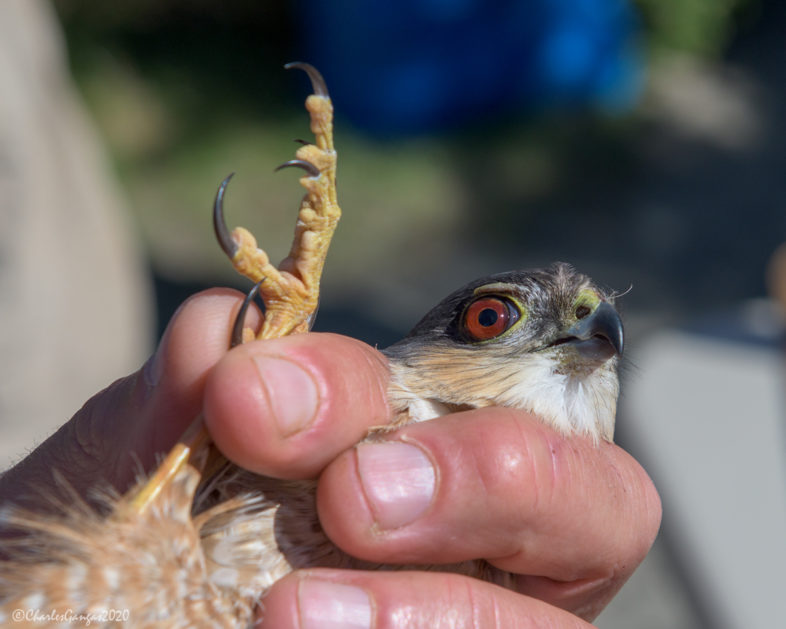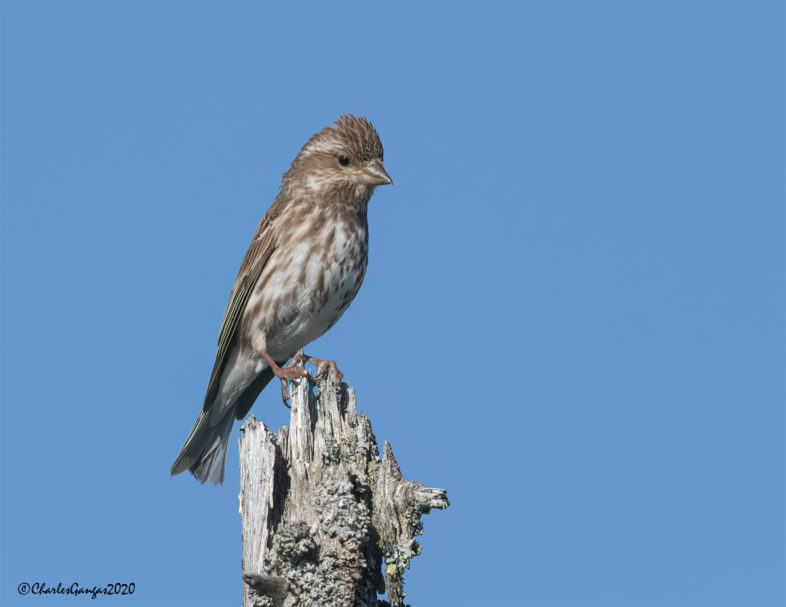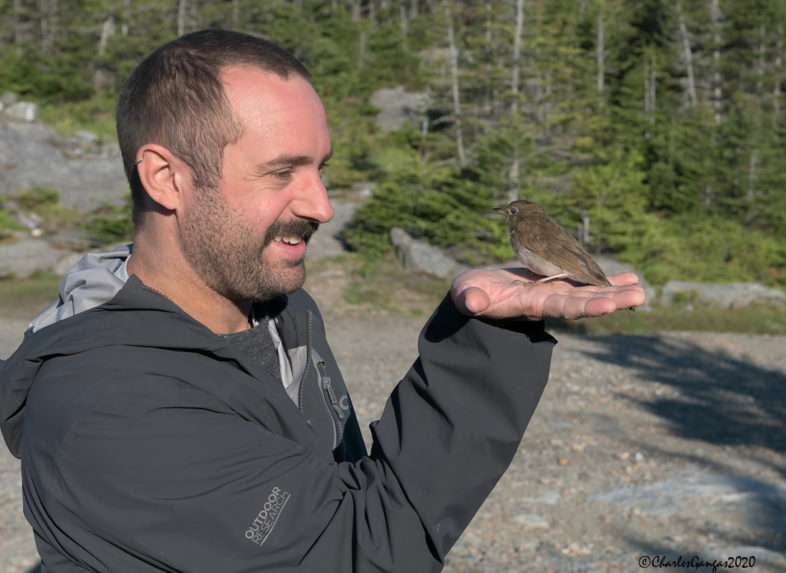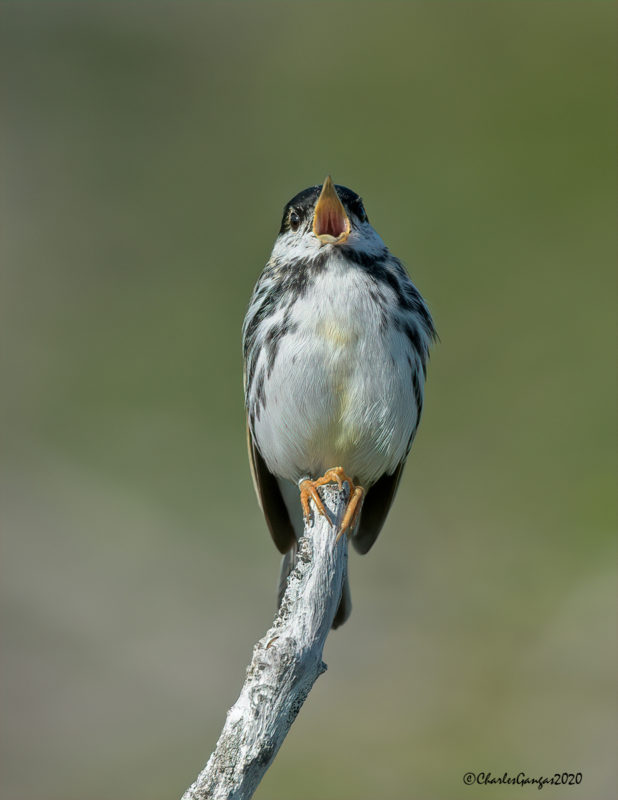
A mist-netted Sharp-shinned Hawk displays its weaponry and casts a baleful glare during banding on Mt. Mansfield, 17 June 2020. © Charles Gangas
What a difference a year makes. After bemoaning our low capture rates during the first half of June a year ago—and the uncomfortably cold, wet weather that at least partly led to them—VCE’s 2020 field season (our 29th on the mountain) is off to a flying start. After 3 weeks, we’ve captured nearly 200 individual birds in our mist nets, twice as many as of mid-June 2019. We’ve carefully timed our visits to coincide with favorable weather, since we’re sleeping under the stars instead of inside the Vail ski patrol hut, and, so far, we’ve lucked out.
With a green light from Vail to ascend the toll road in our vehicles during the early afternoon on June 16 (strangely, I felt a twinge of disappointment at having to miss another ATV ride…), Zac Cota, Anna Peel and I arrived on the ridgeline at 3 pm to idyllic—and exceedingly rare for June—conditions: warm temperatures, clear skies, nary a breath of wind. Our 24 nets were open for business by 5 pm, and we proceeded to capture 35 birds by nightfall, despite a pronounced drop in vocal activity from the previous two weeks. Most females of all species are now incubating, and a few early nesters like robins are brooding or feeding young, so males presumably have less incentive to sing. Even the dusk chorus was surprisingly brief and weak, seemingly uninspired.

A female (or could it be a yearling male?) Purple Finch on the Mansfield ridgeline, 17 June 2020. Numbers of this species—at least in VCE’s mist nets—are at an historic high, with 21 individuals banded so far this season. © Charles Gangas
As they have been since Week 1, Purple Finches were conspicuous on the ridgeline, singing and moving about—we captured 7 before closing nets at dusk. The following morning we netted another 4, bringing our 3-week total to 21 new bandings (only a single within-season retrap). This far eclipses any previous year’s total for the species through mid-June and begs the question of what is happening. A population increase of seed-eating species like this often reflects the prior season’s banner cone crop, and in fact 2019 featured a bumper crop of balsam fir cones in the region’s montane forests. However, some of the other species that track these cyclical crops—crossbills, siskins, and red squirrels among then—are all but absent. The 21 finches we’ve so far banded include 8 ASY (>2 year-old) males, 7 SY (yearling) males (which look nearly identical to females), and 6 females, all of which were in breeding condition. It will be interesting to learn during the weeks ahead whether ‘PUFIgeddon’ continues, or whether numbers drop off.
Hopping out of our sleeping bags at 4 am under clear skies and comfortably cool temps with a slight breeze, we had our nets reopened within 30 minutes. Morning banding was steady, but without our typical pulse of captures at ~7 or 8 am. Highlights included an unbanded male Sharp-shinned Hawk (we catch at least one annually), and several non-local warblers—an adult female Ovenbird (we heard a male sing by our banding station at 5:30 am!), a male Nashville, a female Black-throated Blue, and a SY male Canada.
Among our 65 captures on June 16-17:
Sharp-shinned Hawk — 1 ASY male
Bicknell’s Thrush — 12 (8 males, 4 females); 5 new, 1 return female from 2014, 6 within-season recaptures; all females with fully-developed incubation patches
American Robin — 1 female with brood patch beginning to regress
Purple Finch — 11 new bandings: 3 ASY males, 4 SY males, 4 females with well-developed incubation/brood patches
Dark-eyed Junco (Slate-colored) — 3 (2 new, 1 within-season recapture); female with full-developed incubation patch
White-throated Sparrow — 7 males (4 new, 1 return male from 2018, 2 within-season recaptures
Ovenbird — 1 female with regressing incubation/brood patch; likely a failed breeder
Nashville Warbler — 1 male
Blackpoll Warbler — 17 (6 new, 2 return females from 2018, 9 within-season recaptures); both females with early-stage incubation patches
Black-throated Blue Warbler — 1 female with no incubation/brood patch
Yellow-rumped Warbler (Myrtle) — 9 (5 males, 4 females); 4 new, 2 return males from 2018, 1 return 2019 female, 2 within-season recaptures; females with well-developed incubation patches
Canada Warbler — 1 SY male, our third bird of the season
Encouragingly, for a species that is experiencing widespread declines in the Northeast and elsewhere in its breeding range across the taiga of Canada and Alaska, Blackpoll Warbler numbers on Mansfield’s ridgeline appear to be solid. VCE’s Mountain Birdwatch data show a steep annual decline of 5.1% in this species across the mountains of New York and New England since 2011. The factors responsible for this population drop are not yet known, though analyses by VCE’s Jason Hill suggest that this long-distance migrant—renowned for its spectacular, non-stop, transoceanic fall migration—may already be responding to a warming climate. To date in 2020, we have captured 30 individual Blackpolls (17 males, 13 females) on Mansfield, compared to only 18 birds by the same date in 2019 and 23 in 2018. It’s far too early to draw conclusions, however…
Finally, our capacity to host a banding team larger than 3 people, let alone any visitors, is greatly compromised by the realties of COVID. We truly regret this, as sharing the marvels of both montane birds and Mansfield’s unique setting are among the rewards that most inspire us at VCE to carry on this long-term work. We can only hope that restrictions will continue to ease in Vermont, and that appropriate physical distancing and other safety measures may allow limited visitation before our field season wraps up in late July. Regardless, we’ll continue to offer a virtual experience each week.

Zac Cota and his first-ever handheld Bicknell’s Thrush eye one another with mutual admiration(?). 17 June 2020, Mt. Mansfield. © Charles Gangas


Thank you not only for doing this work but for your lively reports. I enjoy them enormously.
I\m right there with ya, VCE! Thanks for the report…I am remembering the concerns of 2019 and so glad to hear of the 2020 results so far!
Hi Chris,
Being quarantined in Costa Rica, and having missed our spring banding in CT, it was great fun to see your report!
Exciting, too, to see your numbers, with or without an explanation!
Cross fingers for banding in Fall! Best, Judy
Thanks for all your hard work, Chris and team. Interesting news about that PUFIgeddon. (Admittedly, the first time I’ve heard of one 😋.)
Looks like you are off to a good start this season. Hope it continues!